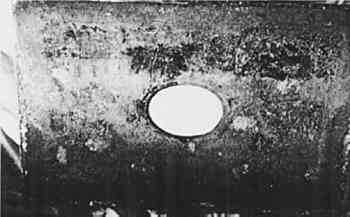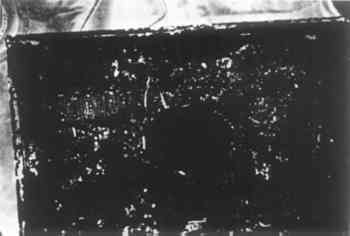PRELIMINARY NOTE ON SETTING DOWN PAINT FLAKING FROM GLASSSidney S. Williston, & Kory R. Berrett
IN SUMMER 1977, we received for treatment a 32 � 52 cm reverse painting on glass from a New England Terry clock. The paint layer was separating from the glass over 25% or more of the area. Many of the individual areas of nonadhering paint had lifted by less than 1 mm, but there were a significant number of places where pieces 1 to 3 cm long had risen by 5 mm. Some detached pieces of paint were curled, some flat (see Figure 1).
We made local tests using swabs, and also immersion tests on small bits of paint with the following solvents: The chips remained very brittle and were easily fractured. The chips were then immersed in solvents for forty-eight hours: At the suggestion of Victor C. B. Covey, Head Conservator, National Gallery of Art, we tried the Pettenkofer method of softening the paint film through the action of solvent vapor. A layer of cotton wet with a solvent mix of 50% methyl ethyl ketone and 50% cellosolve was suspended at a distance of 2.5 cm over the painted surface in an airtight chamber. Progress could be observed through the glass sides of this chamber. After four-and-one half hours of exposure to solvent vapor, the paint chips had visibly relaxed. Upon removal from the vapor chamber, the painted glass panel was placed glass side down on a sheet of low density polyurethane foam approximately 2 cm thick. On the softened paint layer were placed a layer of glassine paper, a layer of soft felt 3 mm thick, and telephone books weighing about 5 kg. The assembly was left for four days; then we removed the weights and began to peel off the glassine paper. We stopped when we noted that a small amount of protective paint (which covered the actual painting) was coming off with the glassine paper. After leaving the panel overnight exposed to air, covered with glassine but without weights, we were able to complete the paper removal without paint loss and to evaluate the results of the treatment. Approximately 95% of the previously detached painted areas had re-adhered to the glass support. Most of the 5% of the paint film area which remained detached
At this point we were faced with two choices: to add some adhesive (e.g. methyl cellulose, acrylic resin or gelatine) to the cracks and around the edges of the losses, or to wait and see if sufficient original adhesion had been reestablished to cure the problem. We chose the latter course and advised the owner of the clock that we We inpainted losses with Magna acrylic colors thinned with xylene. We laid a few small areas of gold leaf in gelatin. We covered the entire back of the paint layer with a low-saturation pale greenish coat of Liquitex acrylic emulsion approximately the color of the original back paint. When the clock door is opened, this surface is exposed to view. THE FEDERAL COUNCIL on the Arts and Humanities has convened a Working Group on Federal Museums Policy and asked it to “report back to the Federal Council with suggestions for improving the coordination of Museum programs.” The working group is composed of representatives from the Institute of Museum Services and from the major museum assistance programs in the National Endowment for the Arts, National Endowment for the Humanities, National Science Foundation, and Smithsonian Institution. To begin, the Working Group is surveying Federal Government support for the nation's museums. DAVID SHUTE, Executive Director of NCAC presented their statement. As an intermediate step in developing the report, the Working Group invited several organizations including AIC and NCAC to submit a written statement and make a brief oral presentation at a meeting on January 20, 1979. PAUL BANKS, President of AIC, prepared the written statement, and asked ANTOINETTE KING, Senior Paper Conservator, The Museum of Modern Art, to attend the meeting and make an oral presentation. Participants had been asked to consider four questions: (1) What are the financial needs of museums that most warrant federal assistance? (2) Do federal programs as currently constituted meet those needs? (3) Are the limited federal assistance resources being applied efficiently and equitably? (4) Are there ways to streamline administrative practices in federal museum programs to serve the museum community better? The Editors of the Journal believe that the present and prospective importance of Federal support for conservation warrants bringing these presentations in full to the membership of the AIC. |


